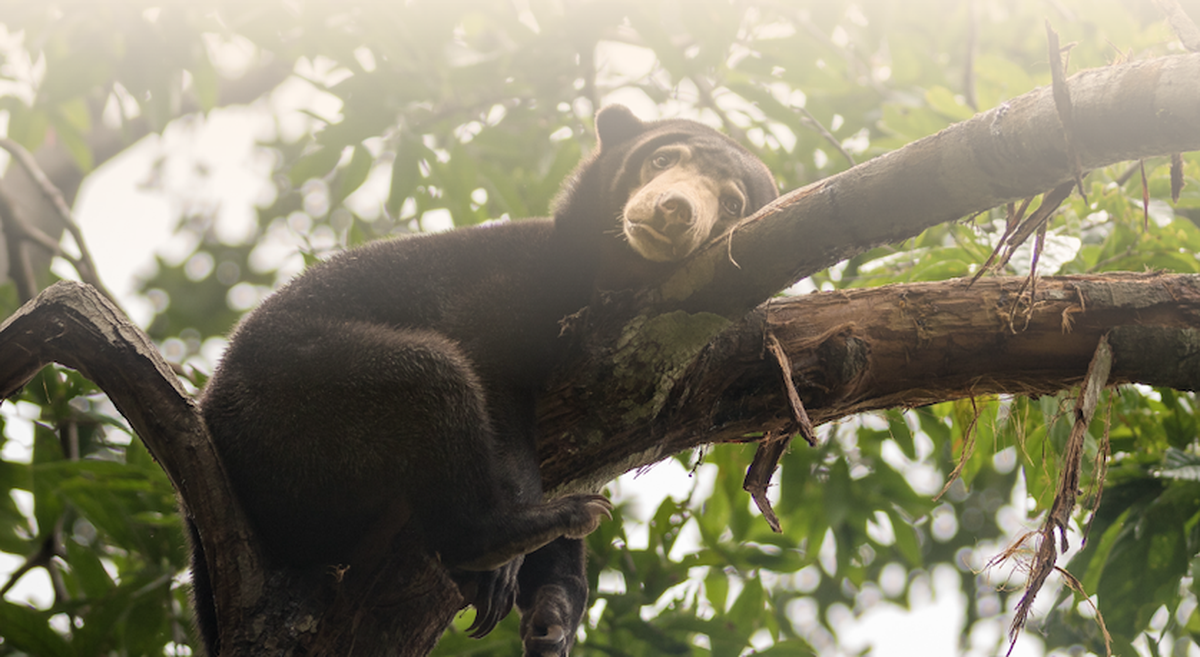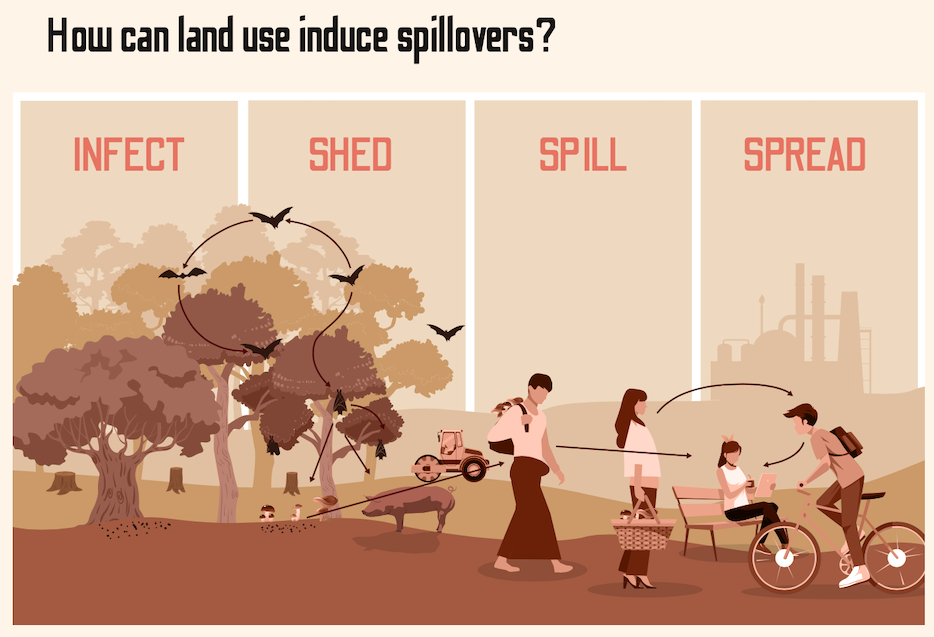
Landscape use-induced spillovers
What is land use-induced spillover?
Many land use types can also play a role in linking infectious disease dynamics. Inappropriate land-use and land-use change, such as deforestation and fragmentation, can force wildlife closer to humans. This proximity introduces stress that leaves wildlife more vulnerable to infection, shedding pathogens from wildlife and changing the distribution of pathogens across the environment. Wildlife can also come in closer contact with livestock (as they often already share the same ecosystems) that can act as intermediate pathogen hosts. Infrastructure development (mining, roads/rail etc.), wetland modifications and urban growth can also drive a cascade of factors, including pollution and human migration, that exacerbate the emergence and transmission of pathogens. These dynamics are what determine a land-use spillover process.

Land use is a primary driver of the cascade called “infect-shed-spill-spread” and, therefore, is extremely important to address to prevent the spillover of pathogens from wildlife to humans.
When a natural habitat is disturbed through habitat fragmentation or destruction, the availability and distribution of resources that are key for wildlife are reduced. The results of these threats cause changes in the trophic structure and hydrology of rivers leading to increased ecosystem stress. Due to decreased resources, wildlife comes closer to each other (infection) and closer to humans. The increased anthropogenic activities (such as agriculture, and urban settlements), further disrupt ecosystems through the contamination and pollution of water, soil and air, introducing additional physiological and nutritional stresses that increase wildlife vulnerability to pathogens. All these factors contribute to the infection and shedding of pathogens. Due to the loss of habitats and/or bushmeat hunting, wildlife-human proximity increases (shedding), contributing to human exposure and the spillover of these pathogens. Declines in human population conditions associated with high levels of mental stress, poor nutrition and increased antimicrobial resistance of bacteria (due to an overuse of antimicrobial drugs on humans, livestock and agriculture) facilitate human susceptibility to infection (spilling) and person-to-person transmission (spreading). Pathogens spill can also tnsmitted from livestock to wildlife endangering; this event is called spillback.
Over the years, the spreading of viruses has shown the interdependence of human, animal and ecosystem health, and their socio-economic consequences:
-
Anthropogenic intervention on the natural habitat was the most prominent contribution to the emergence of the Nipah virus outbreak in Malaysia. Deforestation for plantation and agricultural purposes of the tropical forest resulted in an impenetrable haze over the peninsula, obstructing sunlight and disabling the flowering of fruit trees. This, coupled with climate change events, contributed to the decrease in natural resources available for flying foxes, the host of the Nipa virus, pushing them to migrate to plantations and villages looking for food. Due to agricultural intensification, the overlap of mango plantation (a favourite food for flying foxes) with livestock rearing caused the pathogen to spread from wildlife to livestock to humans. The virus was estimated to have cost over US $582 million of economic losses, severely affecting job security (over 36,000 people lost their job) and businesses outside the pork industry.
-
The Ebola crisis (2013-2015) resulted in 11,310 confirmed human death. Further, the travel restriction measures and enforcement in West Africa during the outbreak led to an increase in poaching, illegal logging and mining. They negatively influenced progress made on water catchment areas, influencing water quality and impacting both people and ecosystems. Further, ebola caused significant die-offs of gorillas, 5,000 in 2 years in one study site, having consequences on eco-tourism as well.
How are humans, animals and the environment linked?
People, animals, plants and the environment are all connected. Changes in biodiversi- ty and ecosystems have an impact on human health not only through disease out- breaks but also may affect agricultural production, hence food security through loss of impollinators and other ecosystems services that regulate water, soil regeneration and climate regulation. On the other hand, social justice and economic prosperity also influence environmental protection. process.

What are the effects of a healthy landscape?
Habitat restoration has essential costs and benefits. Intact ecosystems provide the reduction of disease risk as an ecosystem service, with an easy-to-calculate monetary benefit using cost-of-illness studies that measure per-case health costs, and a contin- gent-valuation survey to measure the perceived value of the protection of biodiversity. On the other hand, the benefits of restoring habitat are non-monetary. They can be defined as improved quality of life/health, protection of biodiversity, and ecosystem services such as carbon storage, flood control, or reduction in disease risk. Having healthy landscapes helps:


References
Becker, D. J., Albery, G. F., Kessler, M. K., Lunn, T. J., Falvo, C. A., Czirják, G. Á., ... & Plowright, R. K. (2020). Macroimmunology: The drivers and consequences of spatial patterns in wildlife immune defence. Journal of Animal Ecology, 89(4), 972-995.
Morlando, S., Schmidt, S. J., & LoGiudice, K. (2012). Reduction in Lyme disease risk as an economic benefit of habitat restoration. Restoration Ecology, 20(4), 498-504.
Plowright, R. K., Reaser, J. K., Locke, H., Woodley, S. J., Patz, J. A., Becker, D. J., ... & Tabor, G. M. (2021). Land use-induced spillover: a call to action to safeguard environmental, animal, and human health. The Lancet Plane- tary Health, 5(4), e237-e245.
Plowright, R. K., Parrish, C. R., McCallum, H., Hudson, P. J., Ko, A. I., Graham, A. L., & Lloyd-Smith, J. O. (2017). Pathways to zoonotic spillover. Nature Reviews Microbiology, 15(8), 502-510.
Rana, S., & Singh, S. (2015). Nipah virus: effects of urbanization and climate change. In 3rd International Confer- ence on biological, chemical & environmental sciences (BCES-2015) (pp. 64-68).
UN.ESCAP (2022). Accelerating one health in Asia and the Pacific



